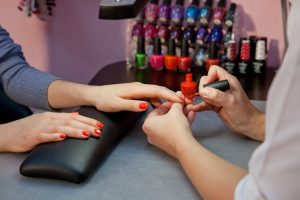Nail polish, glue, acrylic nails, and disinfectants all contain chemicals that can harm workers who use them regularly, at close range, on the fingers and toes of consumers.

Photo credit: iStock.com/TatianaNurieva
Hazardous chemical exposure in nail salons is a WorkSafeBC risk advisory that outlines employers’ responsibility to assess risks in accordance with the Occupational Health and Safety Regulation in B.C.
“Without proper ventilation and personal protective equipment, workers may be exposed to levels that can put them at risk of adverse health effects,” it reads.
Nail salons on the safety radar
Last year, The New York Times published “The Price of Nice Nails,” an in-depth story about manicurists in terrible working conditions with little to no safety or hygiene protection.
Many people read the story, including Janet Lee, an occupational hygiene officer for WorkSafeBC. She and her team wanted to find out what was happening locally, so they visited about 20 nail salons, and talked with industry.
Chemicals in some nail products are known to have negative health effects, but there are few studies focused specifically on nail technicians, Janet says. A definitive link between nail salon products and nail technician health effects has not been proven, although some research has found that nail technicians do report more negative health symptoms compared with the general population.
WorkSafeBC also created the above risk advisory for employers. A “risk advisory” is a way WorkSafeBC shares information about risks not yet found in claims data for a number of reasons. I wrote about this in my post, An evolving approach to injury prevention.
WorkSafeBC’s Prevention team consulted with the Beauty Council of Western Canada, an industry association pushing to improve safety for consumers and workers. The Beauty Council was responsible for certification and regulation of the personal care industry until 2003, when the provincial government deregulated it. Since then, safety and hygiene in the industry has declined, says Fiona Chambers, the Beauty Council’s executive director.
Deregulation allowed new businesses to sell personal care services to the public without any legal need to show that their workers were trained or certified. Fiona says anyone can just open a shop and offer relatively cheap services that cut corners on hygiene and training and put consumers and workers at risk of chemical exposures, infections, and diseases like HIV and hepatitis.
Since 2003, the Beauty Council has offered voluntary certification to self-regulating businesses. In 2015, the Beauty Council had 4,000 members, but in 2003, there were about 20,000, says a rep in this audio piece from CBC Radio West, Should hair stylists, nail technicians and others be regulated?
The Beauty Council is hoping to increase the number of certified operators in B.C. They want municipal governments to implement bylaws that require all personal care operators to take the BeautySafe program, which covers the essentials of infection control, safe cleaning, sterilization, and chemical practices. Personal care operators include not only nail and hair salons but also businesses that do eyebrow microblading, microdermal abrasion, eyelash extensions, tanning, waxing, shaving, and much more.
Says Fiona: “Everybody in our industry should take BeautySafe — that’s what we are pushing for — just like Foodsafe.”
For more information, see:
Leading safety in tattooing and piercing industry, my recent post that describes the same types of risk to workers and consumers
California Healthy Nail Salon Collaborative
Occupational exposure in Ontario nail salons, a study now underway by the Occupational Cancer Research Centre
These 4 Chemicals May Pose the Most Risk for Nail Salon Workers, from Scientific American


